Seringapatam, a fortress in Central India was stormed by British and Native troops commanded by General Harris in 1799. Tipu Sultan, the Tiger of Mysore (or just another French-assisted colonial upstart in a province ripe to be crushed) held sway there after defying (just like his dad) the British Governor-General's directives. In 1792 the Mysorean Army had been reduced when the country was partitioned after the last difference of opinion, but it still numbered over 40,000 men, some of which were cavalry and nicely situated in the British rear, well-placed to raid/attack the lengthy but precious supply trains of draught bullocks (which were dropping down dead with alarming frequency) and a few elephants following after the troops. They were however, of doubtful quality.
During late March Harris arrived, to be joined later by reinforcements on April 14th. Harris carefully reconnoitred'the area on April 5th, altered in defence since the last fighting there in 1792 (by the French engineers who unfortunately got it wrong), and ordered Colonel Arthur Wellesley of the 33rd Foot(yes, embryonic Wellington) to clear out a low-lying area thick with trees near an aqueduct, known as the Sultanpet Tepe, where Tipu's men lurked with rockets and muskets. This was done at night, the redcoats lost their way and became confused, losing some men as prisoners. Wellesley returned in some agitation through this reverse, but recovered and cleared it the next day, learning a valuable lesson.
The Siege Commences
The seige commenced proper with the clearing of several other enemy outposts, and the guns opened on the walls on April 20th, ending the brief exchange of letters between the beseiged and beseigers. A strong counterattack, bombarding the British seige lines in rear with rocket artillery, and infantry attacking toward the front was beaten off on April 22nd. All batteries opened up on April 24th, on the western face of the fortress (and other targets too so as not to give away the point chosen for the assault). The rampart guns were quickly put out of action, a shell exploding the fortress magazine on May 2nd, and by next day, a large breach was opened and made practical. 2400 redcoats and 1800 native soldiers were to storm the breach under the guidance of the reconnoitering officer and gain the rampiuts. Due to the continuing bickering and fighting all round the perimeter of the city's defences during the seige, men from both sides had continued to be active and were well prepared for the assault.
At an hour and a half after noon on May 4th, the attack would begin (when Harris thought the defenders would be enjoying a siesta). Two columns would be headed by two aspiring colonels, and pointed at the breach. At the appointed time, General Baird, a bad-tempered gentleman of Scots ancestry (no doubt greatly increased in spleen by a three and a half year imprisonment in Seringapatam seven years previously, wounded and chained to the dungeon walls), stepped forward, drew his sword and told the men in no uncertain terms what to do and where to do it!
The two columns made fast work of plunging down into the river bed, splashing across, scrambling up the rubble, doing away with the defenders and finally planting the colours on the ramparts, all done in six minutes flat. The two columns then broke away to right and left, following the general plan to meet abiove the eastern gate and control the city, killing the defenders when and where they found them. Along the northern ramparts, the fighting was fiercest, as Tipu himself was there, urging on his disheartened men, and for a short time they held ; then some soldiers of the 12th Foot got behind them and started to shoot them down.
Tipu fled, bleeding from two bayonet wounds, riding his horse toward the water-gate halfway along the northern perimeter. Almost there, he was shot and wounded by a redcoat soldier who only saw a richly dressed Indian and a chance for plunder - falling from his horse, Tipu leapt up with his sword and was shot again, this time through the temple by a soldier whose eye was caught by the enormous ruby in his turban, and was pounced on by the redcoats. The Mysorean troops with him were all killed on the spot, then trampled over in the mad rush for the Palace loot.
Views of the Sultanpet tope, from the aquaduct. Re-engineering of the aquaduct and thinning out of the trees for rice paddies mean the tope is probably neater and less dense today than in 1799.
By 2.30 in the afternoon, it was all over. General Baird had entered the Palace sword in hand threatening dire consequences - despite other officers' offers of good treatment in terms for surrender - if Tipu wasn't found or gave himself up (no doubt remembering the harsh imprisonment that he himself had suffered there, and after hearing rumours that Tipu had ordered the prisoners in the dungeons put to death just prior to the storming), pushing past the redcoats with dripping bayonets busily turning the place upside down in the hunt for plunder, setting fires, raping, killing and smashing up all the furniture of no immediate value - they had all heard the rumours too ....
On the evening of the 4th, after a search through heaps of bodies, Tipu was found by torchlight under a heap of dead, still warm and looking remarkably well (but missing his ruby, gold belt and jewelled armlets) by Wellesley, who felt for the pulse and pronounced him dead.
As Tipu's body was carried out of the city later that day, the 5th May, escorted by two companies of stout European grenadiers for safety, towards the family mausoleum for interment, a British officer stepped forward and snipped off one of Tipu's moustachios with a pocketknife for a souvenir - as Tipu's violated body was carried into the vault, a tremendous thunderstorm erupted in the heavens (an occasion where it occurred after rather than before a 'Wellingtonian' victory) and the river running past the fortress swelled in flood - just too late to save him from the swarming assault parties splashing across.
On the 6th, General Baird (further increasing his spleen) was releived of the lucrative post of commandant in the city by Wellesley, a cooler and more respected head for administration and restoration. Wellesley had Tipu's roaming pet tigers shot, put out the fires, and threw out of the city the remaining red-eyed and bloodyhanded redcoats - after hanging four of the worst ones. All that remained was to count the cost, around 300 dead and 1200 missing; and millions (sterling) in the form of jewels, precious metals, art treasures and minted coins - mostly in the hands of the reeking soldiery to be found, sorted, and paid out to the victors as prize money. Harris got 150,000 pounds; Wellesley got 4000 pounds (just about the size of his debts), and the surviving soldiers (officially) got a fiver for their trouble.
Past Wargamed
I saw this wargamed many years ago as part of research for our 'seige mentality' period on a large sandtable (we ended up doing the 'Alamo' instead). Tipu's troops with their diversity of weapons (Airfix "Confederates" with a few Romans and Ancient Britons would you beleive) wore shirt-like overalls with a tigerstripe-like lozenge colouration, and the British redcoats (Airfix "Union") had native levies and an equally decorative baggage train (part of which were sheep, cows and pigs painted grey representing bullocks !), amid palm trees and rivers with one of the players wearing a fez. It looked great ! - rather like a cross between my herb garden and a model railway layout.
Cornwell's New Sharpe Novel
For those whose taste-buds have been tantalised by this oriental touch and wish to indulge further, Bernard Cornwell is bringing out a new novel, "Sharpe's Tiger", based on Richard Sharpe's service with the 33rd Foot in India, later in 1996. Two good books to read in the meantime are :'Tiger of Mysore' by Denys Forrest ; and of course, 'Wellington In India' by Jac Weller. Several of the artifacts brought out of Tipu's palace ; the jewelled Uma bird throne and crystal tigerhead (Windsor Castle), the model tiger complete with growl (Victoria & Albert Museum), Tipu's helmet, weapons and armour (Wallace Collection) ; can be seen in and around London, and give some idea of the splendour that must have been all too tempting for the rapacious redcoats
This article appears in MagWeb (Magazine Web) on the Internet World Wide Web.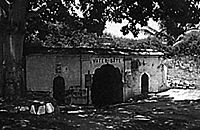 South entrance to the Water Gate...but is it in the wrong place?
South entrance to the Water Gate...but is it in the wrong place?
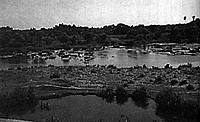 Looking back along the assault route: cross th river, up theglacis, across the inner ditch, and up the breach--in six minutes.
Looking back along the assault route: cross th river, up theglacis, across the inner ditch, and up the breach--in six minutes.
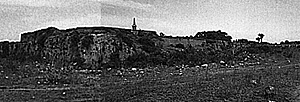 North wall and breach in northwest bastion.
North wall and breach in northwest bastion.
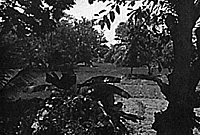
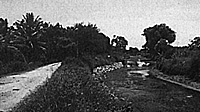 All Over
All Over
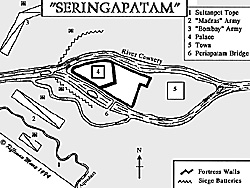 Bernard's recent visit in May 1996 discovered that the map in Jac Weller's book (Wellington In India) is slightly flawed, showing the location of the Water Gate too far west (when I toured the Crimean battlefields between 1992/4, I found such small deviations - including an extra valley - even on large scale maps). His survey also covered aspects of where the inner wall, completely gone now but built in a hurry from mud bricks between 1794 and 1799, exactly was in relation to the existing gate, which by translating the Indian accounts of Tipu's death, may not be the actual site of Tipu's death. Bernard visited the site at the same time of year as the siege and assault - the temperature never dropped below 93 degrees during the day!
Bernard's recent visit in May 1996 discovered that the map in Jac Weller's book (Wellington In India) is slightly flawed, showing the location of the Water Gate too far west (when I toured the Crimean battlefields between 1992/4, I found such small deviations - including an extra valley - even on large scale maps). His survey also covered aspects of where the inner wall, completely gone now but built in a hurry from mud bricks between 1794 and 1799, exactly was in relation to the existing gate, which by translating the Indian accounts of Tipu's death, may not be the actual site of Tipu's death. Bernard visited the site at the same time of year as the siege and assault - the temperature never dropped below 93 degrees during the day!
Back to Table of Contents -- First Empire #31
© Copyright 1996 by First Empire.
Other military history articles and gaming articles are available at http://www.magweb.com